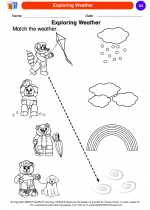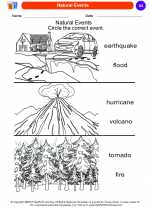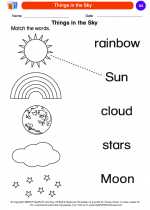The Water Cycle
The water cycle, also known as the hydrological cycle, is the continuous movement of water on, above, and below the surface of the Earth. It involves the processes of evaporation, condensation, precipitation, and transpiration.
Process of the Water Cycle
- Evaporation: This is the process by which water from the Earth's surface, such as oceans, rivers, and lakes, is heated by the sun and changes into water vapor, which rises into the atmosphere.
- Condensation: As the water vapor rises, it cools and condenses to form clouds. This is the process by which water vapor changes into liquid water droplets.
- Precipitation: When the water droplets in the clouds become heavy enough, they fall to the Earth as rain, snow, sleet, or hail.
- Transpiration: This is the process by which water is taken up by the roots of plants and released into the atmosphere as water vapor through the leaves.
- Runoff: When precipitation falls on the land, it may flow over the surface of the ground as runoff, eventually making its way back to the oceans, rivers, and lakes.
Importance of the Water Cycle
The water cycle is essential for maintaining the Earth's water supply, supporting plant and animal life, and regulating the Earth's climate. It helps to distribute water across the planet and plays a crucial role in the global water and energy balance.
Study Guide
Here are some key points to remember about the water cycle:
- Identify the main processes of the water cycle: evaporation, condensation, precipitation, and transpiration.
- Understand the role of the sun in driving the water cycle by providing the energy for evaporation.
- Explain the importance of the water cycle in maintaining the Earth's water supply and supporting life.
- Describe how water moves through the water cycle, from the Earth's surface to the atmosphere and back again.
It's also helpful to study diagrams and illustrations of the water cycle to visualize the processes and their interconnectedness.
Remember to review and practice these concepts to gain a solid understanding of the water cycle!
[The Water Cycle] Related Worksheets and Study Guides:
.◂Science Worksheets and Study Guides Kindergarten. Weather

 Coloring Worksheet
Coloring Worksheet
 Coloring Worksheet
Coloring Worksheet
 Coloring Worksheet
Coloring Worksheet
 Coloring Worksheet
Coloring Worksheet
 Coloring Worksheet
Coloring Worksheet
 Coloring Worksheet
Coloring Worksheet
 Coloring Worksheet
Coloring Worksheet
 Coloring Worksheet
Coloring Worksheet
 Coloring Worksheet
Coloring Worksheet
 Coloring Worksheet
Coloring Worksheet
 Coloring Worksheet
Coloring Worksheet
 Coloring Worksheet
Coloring Worksheet
 Coloring Worksheet
Coloring Worksheet
 Coloring Worksheet
Coloring Worksheet
 Coloring Worksheet
Coloring Worksheet
 Coloring Worksheet
Coloring Worksheet
 Coloring Worksheet
Coloring Worksheet
 Coloring Worksheet
Coloring Worksheet
 Coloring Worksheet
Coloring Worksheet
